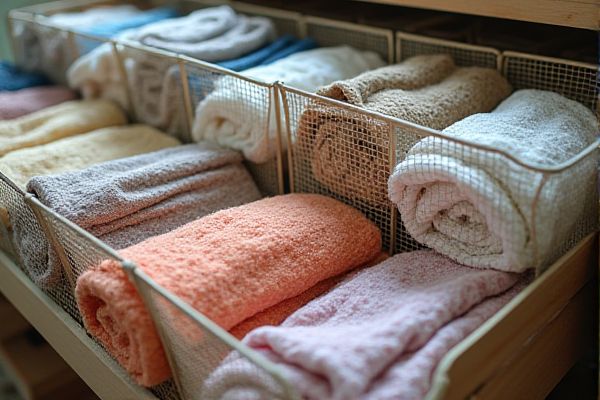
Mesh sorters provide enhanced airflow and visibility for sorting items efficiently, while divided fabric sorters offer separate compartments for organized storage and protection of delicate materials. Explore the rest of the article to discover which option best suits your specific sorting needs.
Table of Comparison
| Feature | Mesh Sorter | Divided Fabric Sorter |
|---|---|---|
| Sorting Mechanism | Perforated mesh belt enables lightweight, breathable sorting | Segmented fabric sections allow precise item separation |
| Material Compatibility | Ideal for lightweight and flexible materials | Suitable for diverse fabric types and heavier items |
| Durability | Moderate - mesh can wear over time | High - reinforced fabric sections enhance longevity |
| Maintenance | Easy cleaning due to open mesh design | Requires regular inspection for fabric integrity |
| Cost | Generally lower initial investment | Higher upfront cost but better long-term value |
| Applications | Light textile sorting, agricultural sorting | Heavy textile sorting, industrial fabric handling |
| Efficiency | Good for fast, lightweight sorting tasks | Optimized for precise sorting and heavy-duty use |
Introduction to Laundry Sorters
Laundry sorters enhance organization and efficiency in garment care by categorizing clothes before washing. Mesh sorters provide breathable compartments that reduce moisture buildup and odors, making them ideal for delicate or damp fabrics. Divided fabric sorters offer rigid sections that prevent fabric tangling and maximize space, accommodating heavier laundry loads effectively.
What is a Mesh Sorter?
A Mesh Sorter is a specialized industrial machine designed to efficiently separate materials based on size using a mesh screen. It excels in sorting fabrics or granular materials by allowing smaller particles to pass through mesh openings while larger items remain on top. Your choice of a mesh sorter enhances precision in material grading compared to divided fabric sorters, which rely on sectioning rather than mesh filtration.
What is a Divided Fabric Sorter?
A Divided Fabric Sorter is a specialized machine designed to separate and organize different types or colors of fabric efficiently during production. This sorter uses physical dividers to categorize fabric pieces, ensuring precision in sorting and minimizing fabric damage compared to mesh sorters. Your choice of a divided fabric sorter can enhance workflow accuracy and optimize fabric handling in textile manufacturing.
Key Features Comparison
Mesh sorters feature a breathable, lightweight design that enhances airflow and reduces static buildup, making them ideal for delicate or moisture-sensitive fabrics. Divided fabric sorters offer distinct compartments or slots, enabling efficient categorization and separation of multiple fabric types or colors during sorting processes. Both systems improve organization, but mesh sorters prioritize ventilation while divided sorters emphasize compartmentalized sorting efficiency.
Durability and Material Quality
Mesh sorters are typically crafted from high-grade nylon or polyester mesh, offering superior breathability and resistance to wear and tear, which enhances their durability in humid conditions. Divided fabric sorters often use sturdy canvas or woven polyester materials that provide robust structural support but may be less breathable, potentially affecting long-term fabric integrity. The choice between mesh and divided fabric impacts durability significantly, with mesh excelling in ventilation and fabric sorters delivering stronger resistance to heavy loads and abrasion.
Ventilation and Odor Control
Mesh sorters provide superior ventilation due to their open structure, allowing air to circulate freely and significantly reducing moisture buildup and odor retention. Divided fabric sorters, while offering compartmentalized organization, tend to trap heat and odors within enclosed sections, limiting airflow. Your choice should prioritize mesh sorters for effective odor control and ventilation in storage.
Capacity and Space Efficiency
Mesh sorters offer high capacity and superior space efficiency by utilizing open-grid construction, allowing better airflow and visibility, which optimizes fabric storage without occupying excessive floor space. Divided fabric sorters, although providing organized compartments for different fabric types or colors, generally require more space due to solid partitions and may have lower capacity compared to mesh sorters. Your choice depends on balancing storage needs with available space, where mesh sorters maximize capacity and minimize footprint.
Ease of Use and Portability
Mesh sorters are lightweight and flexible, offering superior portability and easy handling compared to divided fabric sorters. Their breathable design reduces bulk, making them ideal for travel and quick access. Divided fabric sorters, while structured for better organization, tend to be heavier and less compact, limiting ease of transport and storage.
Cleaning and Maintenance
Mesh sorters offer easier cleaning and maintenance due to their open design, which allows debris and dust to pass through without clogging. Divided fabric sorters, with tighter fabric partitions, require more frequent manual cleaning to prevent buildup and maintain efficiency. Your choice depends on the balance between maintenance effort and sorting precision needed in your application.
Choosing the Right Sorter for Your Needs
When selecting between a mesh sorter and a divided fabric sorter, consider your specific sorting requirements and fabric types. Mesh sorters offer superior airflow and visibility, making them ideal for delicate or sheer materials, while divided fabric sorters provide organized compartments suitable for bulkier or mixed textiles. Your choice should align with fabric care needs and sorting efficiency to optimize workflow.
 homyna.com
homyna.com